Adaptive Stretch-Forming Process: A Computer Vision and Statistical Analysis Approach
Abstract
1. Introduction
2. ASFP Algorithm and Industrial Setup
3. Results
3.1. Statistical Analysis Programming Process
3.2. Overall Results for the Adaptive Stretch-Forming Process Algorithm
4. Discussion
5. Conclusions
Author Contributions
Funding
Institutional Review Board Statement
Informed Consent Statement
Data Availability Statement
Acknowledgments
Conflicts of Interest
References
- Manikandan, G.; Verma, R.K.; Biswas, P. Effect of friction in stretch forming and its influence on the forming limit curve. Proc. Inst. Mech. Eng. Part B J. Eng. Manuf. 2015, 229, 973–981. [Google Scholar] [CrossRef]
- Sun, L.; Cai, Z.; He, D.; Li, L. Aluminum alloy sheet-forming limit curve prediction based on original measured stress–strain data and Its application in stretch-forming process. Metals 2019, 9, 1129. [Google Scholar] [CrossRef]
- Corona, E. A simple analysis for bend-stretch forming of aluminum extrusions. Int. J. Mech. Sci. 2004, 46, 433–448. [Google Scholar] [CrossRef]
- Zhu, J.-H.; Gu, X.-J.; Zhang, W.-H.; Beckers, P. Structural design of aircraft skin stretch-forming die using topology optimization. J. Comput. Appl. Math. 2013, 246, 278–288. [Google Scholar] [CrossRef]
- Mellor, P.B. Sheet-metal forming. Int. Met. Rev. 1981, 26, 1–20. [Google Scholar] [CrossRef]
- Doege, E.; Dröder, K. Processing of magnesium sheet metals by deep drawing and stretch forming. Matériaux Tech. 1997, 85, 19–23. [Google Scholar] [CrossRef]
- Badrish, A.; Morchhale, A.; Kotkunde, N.; Singh, S.K. Influence of material modeling on warm forming behavior of nickel based super alloy. Int. J. Form. 2020, 13, 445–465. [Google Scholar] [CrossRef]
- Han, Q.; Wang, J.; Han, Z.; Niu, S.; Zhang, J.; Liu, Z.; Li, M. Design of a flexible bio-inspired stretch-forming machine for the fabrication of large radius bends parts. Int. J. Adv. Manuf. Technol. 2020, 108, 3571–3578. [Google Scholar] [CrossRef]
- Wang, Y.; Liu, D.-Z.; Li, R. Numerical investigation for the flexible stretch-stamp forming process of sheet metal. Adv. Mech. Eng. 2019, 11, 1–11. [Google Scholar] [CrossRef]
- Liang, J.; Liao, Y.; Li, Y.; Liang, C. Study on the influence of bending angle of multipoint stretch-bending of profiles on Section distortion of parts. Math. Probl. Eng. 2020, 2020, 1975805. [Google Scholar] [CrossRef]
- Marciniak, Z.; Kuczyński, K. Limit strains in the processes of stretch-forming sheet metal. Int. J. Mech. Sci. 1967, 9, 609–620. [Google Scholar] [CrossRef]
- Bayoumi, A.E.; Joshi, R. On the formability/instability of stretch-forming sheet metals. Appl. Mech. Rev. 1992, 45, S154–S164. [Google Scholar] [CrossRef]
- Narooei, K.; Karimi Taheri, A. A study on sheet formability by a stretch-forming process using assumed strain FEM. J. Eng. Math. 2009, 65, 311–324. [Google Scholar] [CrossRef]
- Dixit, P.M.; Dixit, U.S. Plasticity: Fundamentals and Applications, 1st ed.; CRC Press: Boca Raton, FL, USA, 2015. [Google Scholar]
- Bridgman, P.W. Effects of High Shearing Stress Combined with High Hydrostatic Pressure. Volume V Collected Experimental Papers; Harvard University Press: Cambridge, MA, USA, 2013; Volume 5, pp. 2929–2952. [Google Scholar] [CrossRef]
- Yang, S.-Y.; Lee, D.-B.; Choi, K.-H.; Kim, N.-S.; Ha, S.-H.; Kim, B.-H.; Yoon, Y.-O.; Lim, H.-K.; Kim, S.K.; Kim, Y.-J. Stretch forming behavior and constitutive equation of a modified 5083 alloy with high Mg content at elevated temperatures. Metals 2021, 11, 410. [Google Scholar] [CrossRef]
- Papaioanu, A.; Liewald, M. Further development of the SCS stretch-forming technology with assistance of forming simulation. Int. J. Mater. Form. 2010, 3, 155–158. [Google Scholar] [CrossRef]
- Yu, J.; Li, Y.; Teng, F.; Liang, J.; Lin, X.; Liang, C.; Chen, G.; Sun, G. Research on the cross section forming quality of three-dimensional multipoint stretch forming parts. Adv. Mater. Sci. Eng. 2018, 2018, 4265617. [Google Scholar] [CrossRef]
- Görtan, M.O.; Türkmen, Ü. Finite element analysis of stretch forming of an open Profile made of ultra-high strength martensitic MS1500 steel. In Proceedings of the ESAFORM 2021 24th International Conference on Material Forming, Liège, Belgum, 14–16 April 2021. [Google Scholar] [CrossRef]
- Sun, L.; Cai, Z.; Li, X. Research on contact state and Its effect on forming precision in uniform-contact stretch forming based on loading at multi-position. Metals 2019, 9, 719. [Google Scholar] [CrossRef]
- Park, J.-W.; Kim, Y.-B.; Kim, J.; Kang, B.-S. Study on multiple die stretch forming for curved surface of sheet metal. Int. J. Precis. Eng. Manuf. 2014, 15, 2429–2436. [Google Scholar] [CrossRef]
- Trzepieciński, T. Recent Developments and Trends in Sheet Metal Forming. Metals 2020, 10, 779. [Google Scholar] [CrossRef]
- Cai, Z.-Y.; Wang, S.-H.; Xu, X.-D.; Li, M.-Z. Numerical simulation for the multi-point stretch forming process of sheet metal. J. Mater. Process. Technol. 2009, 209, 396–407. [Google Scholar] [CrossRef]
- Kadhim, A.K.J.; Abbas, M.I. Influence of die elements shapes on process parameters in multi-point sheet metal forming process. In Proceedings of the 3rd International Conference on Management, Economics and Social Sciences (ICMESS’2013), Kuala Lumpur, Malaysia, 8–9 January 2013. [Google Scholar]
- Cui, X.; Mo, J.; Li, J.; Xiao, X.; Zhou, B.; Fang, J. Large-scale sheet deformation process by electromagnetic incremental forming combined with stretch forming. J. Mater. Process. Technol. 2016, 237, 139–154. [Google Scholar] [CrossRef]
- He, D.; Li, X.; Li, D.; Yang, W. Process design for multi-stage stretch forming of aluminium alloy aircraft skin. Trans. Nonferrous Met. Soc. China 2010, 20, 1053–1058. [Google Scholar] [CrossRef]
- Peng, J.; Li, W.; Han, J.; Wan, M.; Meng, B. Kinetic locus design for longitudinal stretch forming of aircraft skin components. Int. J. Adv. Manuf. Technol. 2016, 86, 3571–3582. [Google Scholar] [CrossRef]
- Bohlen, J.; Cano, G.; Drozdenko, D.; Dobron, P.; Kainer, K.U.; Gall, S.; Müller, S.; Letzig, D. Processing effects on the formability of magnesium alloy sheets. Metals 2018, 8, 147. [Google Scholar] [CrossRef]
- Kurukuri, S.; Miroux, A.; Wisselink, H.; van den Boogaard, T. Simulation of stretch forming with intermediate heat treatments of aircraft skins. Int. J. Mater. Form. 2011, 4, 129–240. [Google Scholar] [CrossRef]
- Rahmatabadi, D.; Pahlavani, M.; Marzbanrad, J.; Hashemi, R.; Bayati, A. Manufacturing of three-layered sandwich composite of AA1050/LZ91/AA1050 using cold roll bonding process. Proceedings of the Institution of Mechanical Engineers, Part B. J. Eng. Manuf. 2021, 235, 1363–1372. [Google Scholar] [CrossRef]
- Li, X.; Dong, H.; Guo, G.; Li, D. Hot stretch forming of titanium sheet by resistance heating. In Proceedings of the 5th International Conference on New Forming Technology (ICNFT 2018), Bremen, Germany, 18–21 September 2018. [Google Scholar] [CrossRef][Green Version]
- Deng, T.; Li, D.; Li, X.; Ding, P.; Zhao, K. Hot stretch bending and creep forming of titanium alloy profile. Procedia Eng. 2014, 81, 1792–1798. [Google Scholar] [CrossRef]
- Astarita, A.; Armentani, E.; Ceretti, E.; Giorleo, L.; Mastrilli, P.; Paradiso, V.; Scherillo, F.; Squillace, A.; Velotti, C. Hot Stretch Forming of a Titanium Alloy Component for Aeronautic: Mechanical and Modeling. In The Current State-of-the-Art on Material Forming; Trans Tech Publications Ltd.: Kapellweg, Switzerland, 2013; Volume 554, pp. 647–656. [Google Scholar] [CrossRef]
- Xia, J.Y.; Llewellyn, D.T. Modelling of stretch forming behaviour in steel strip using finite element method. Mater. Sci. Technol. 1994, 10, 233–238. [Google Scholar] [CrossRef]
- Wang, J.; Wu, X.; Thomson, P.F.; Flitman, A. A neural networks approach to investigating the geometrical influence on wrinkling in sheet metal forming. J. Mater. Process. Technol. 2000, 105, 215–220. [Google Scholar] [CrossRef]
- Liu, S.; Xia, Y.; Shi, Z.; Yu, H.; Li, Z.; Lin, J. Deep learning in sheet metal bending with a novel theory-guided deep neural network. IEEE/CAA J. Autom. Sin. 2021, 8, 565–581. [Google Scholar] [CrossRef]
- Akrichi, S.; Abbassi, A.; Abid, S.; ben Yahia, N. Roundness and positioning deviation prediction in single point incremental forming using deep learning approaches. Adv. Mech. Eng. 2019, 11, 1–15. [Google Scholar] [CrossRef]
- Teng, F.; Zhang, W.; Liang, J.; Gao, S. Springback prediction and optimization of variable stretch force trajectory in three-dimensional stretch bending process. Chin. J. Mech. Eng. 2015, 28, 1132–1140. [Google Scholar] [CrossRef]
- Ha, T.; Ma, J.; Blindheim, J.; Welo, T.; Ringen, G.; Wang, J. A computer vision-based, in-situ springback monitoring technique for bending of large profiles. In Proceedings of the ESAFORM 2021, Liège, Belgium, 14–16 April 2021. [Google Scholar]
- Bradski, G. The OpenCV Library. Dr. Dobb’s J. Softw. Tools Prof. Program. 2000, 11, 120–125. [Google Scholar]
- Harris, C.R.; Millman, K.J.; van der Walt, S.J.; Gommers, R.; Virtanen, P.; Cournapeau, D.; Wieser, E.; Taylor, J.; Berg, S.; Smith, N.J.; et al. Array programming with NumPy. Nature 2020, 585, 357–362. [Google Scholar] [CrossRef]
- Seabold, S.; Perktold, J. Statsmodels: Econometric and statistical modeling with python. In Proceedings of the 9th Python in Science Conference (SCIPY 2010), Austin, TX, USA, 28 June–3 July 2010. [Google Scholar]
- PySerial Documentation. 2020. Available online: https://pyserial.readthedocs.io/en/latest/ (accessed on 10 July 2020).
- Hunter, J.D. Matplotlib: A 2D graphics environment. Comput. Sci. Eng. 2007, 9, 90–95. [Google Scholar] [CrossRef]
- OpenCV Color Conversions. Available online: https://docs.opencv.org/3.4.15/de/d25/imgproc_color_conversions.html (accessed on 10 July 2020).
- Illingworth, J.; Kittler, J. The adaptive hough transform. IEEE Trans. Pattern Anal. Mach. Intell. 1987, 5, 690–698. [Google Scholar] [CrossRef]
- OpenCV Object Tracking. Available online: https://docs.opencv.org/4.5.3/dc/d6b/group__video__track.html (accessed on 10 July 2020).
- Ononiwu, N.H.; Ozoegwu, C.G.; Madushele, N.; Akinlabi, E.T. Effects of carbonised eggshells on the mechanical properties, microstructure and corrosion resistance of AA1050 of metal matrix composites. Adv. Mater. Process. Technol. 2021, 1–12. [Google Scholar] [CrossRef]
- Rodríguez, R.S.L.; Díaz, A.J.H.; Hernández, H.L.S.; Pérez-Gutiérrez, F.G.; Zhilyaev, A.P.; Calvo, J.; Cabrera, J.-M. Enhancement of pitting corrosion resistance for AA1050 processed by continuous closed die forging. J. Mater. Res. Technol. 2020, 9, 13185–13195. [Google Scholar] [CrossRef]
- Alishavandi, M.; Ebadi, M.; Alishavandi, S.; Kokabi, A.H. Microstructural and mechanical characteristics of AA1050/mischmetal oxide in-situ hybrid surface nanocomposite by multi-pass friction stir processing. Surf. Coat. Technol. 2020, 388, 125488. [Google Scholar] [CrossRef]
- Koprowski, P.; Sztwiertnia, K.; Bogucki, R.; Bieda, M.; Kawałko, J. Thermal stability of AA1050 aluminum alloy after equal channel angular pressing. Arch. Metall. Mater. 2017, 62, 777–786. [Google Scholar] [CrossRef][Green Version]
- Szachogluchowicz, I.; Sniezek, L.; Slezak, T.; Kluczyński, J.; Grzelak, K.; Torzewski, J.; Fras, T. Mechanical properties analysis of the AA2519-AA1050-Ti6Al4V explosive welded laminate. Materials 2020, 13, 4348. [Google Scholar] [CrossRef]
- ASM Handbook. Properties and Selection: Nonferrous Alloys and Special-Purpose Materials; ASM International: Materials Park, OH, USA, 1990; Volume 2, p. 42. [Google Scholar]
- What Is Design of Experiments (DOE). Available online: https://asq.org/quality-resources/design-of-experiments (accessed on 28 September 2021).


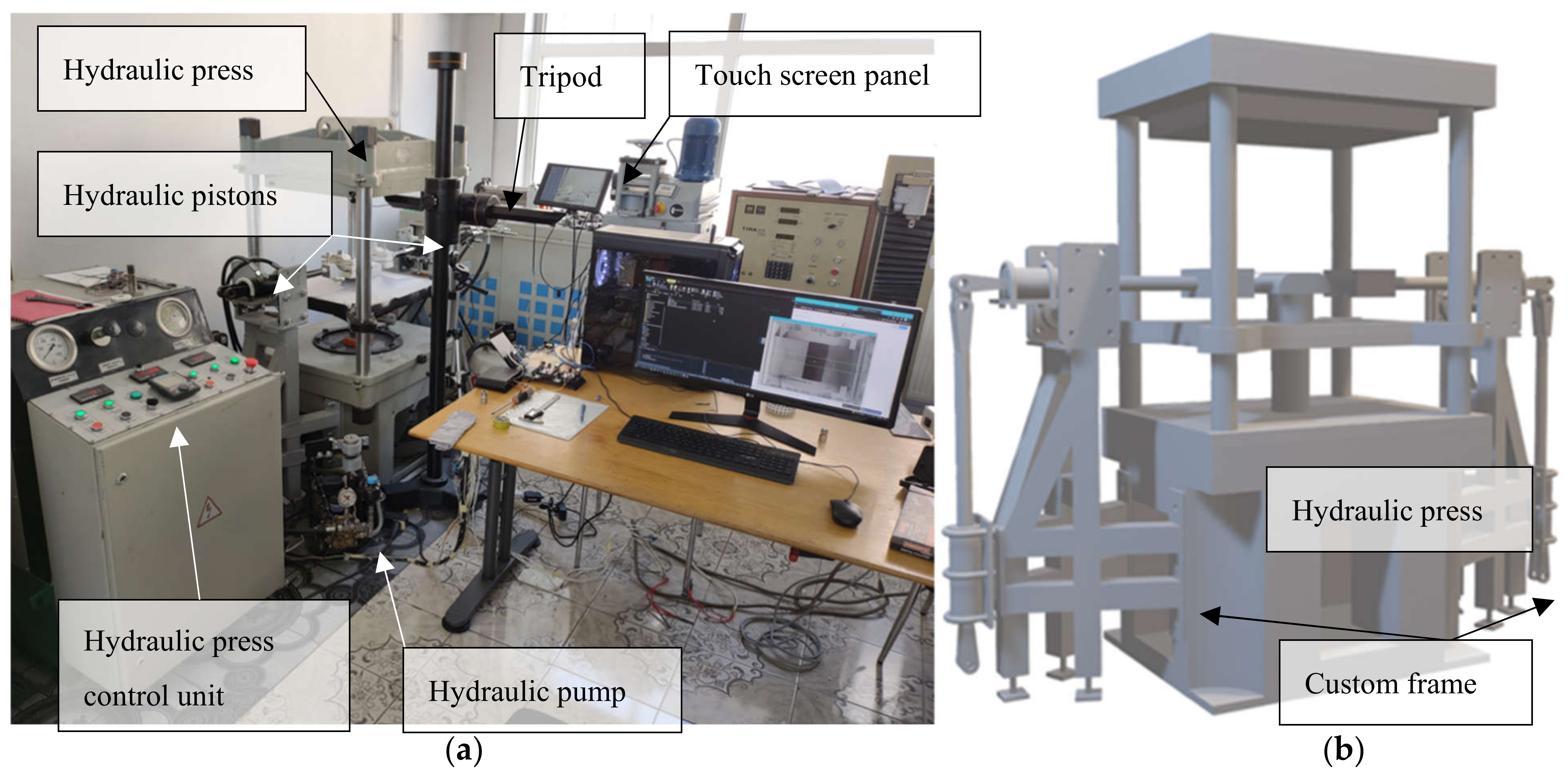



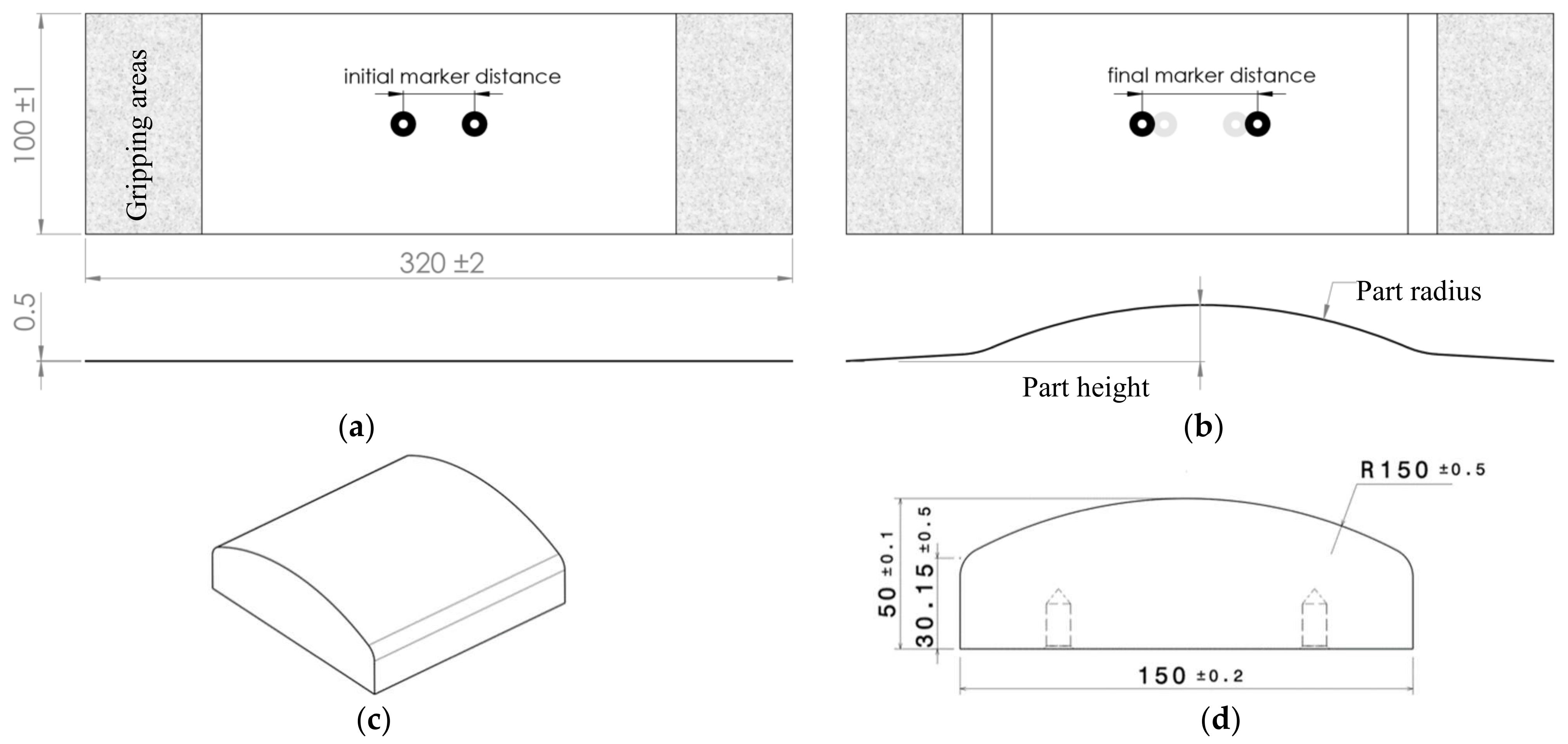

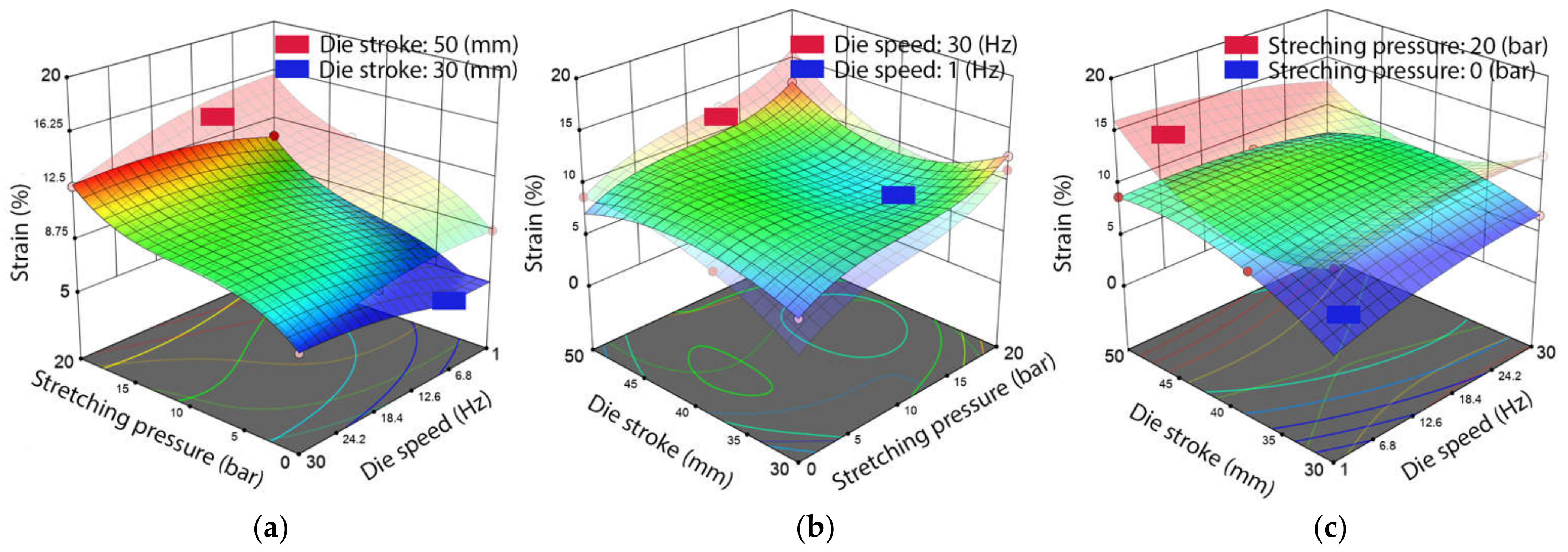


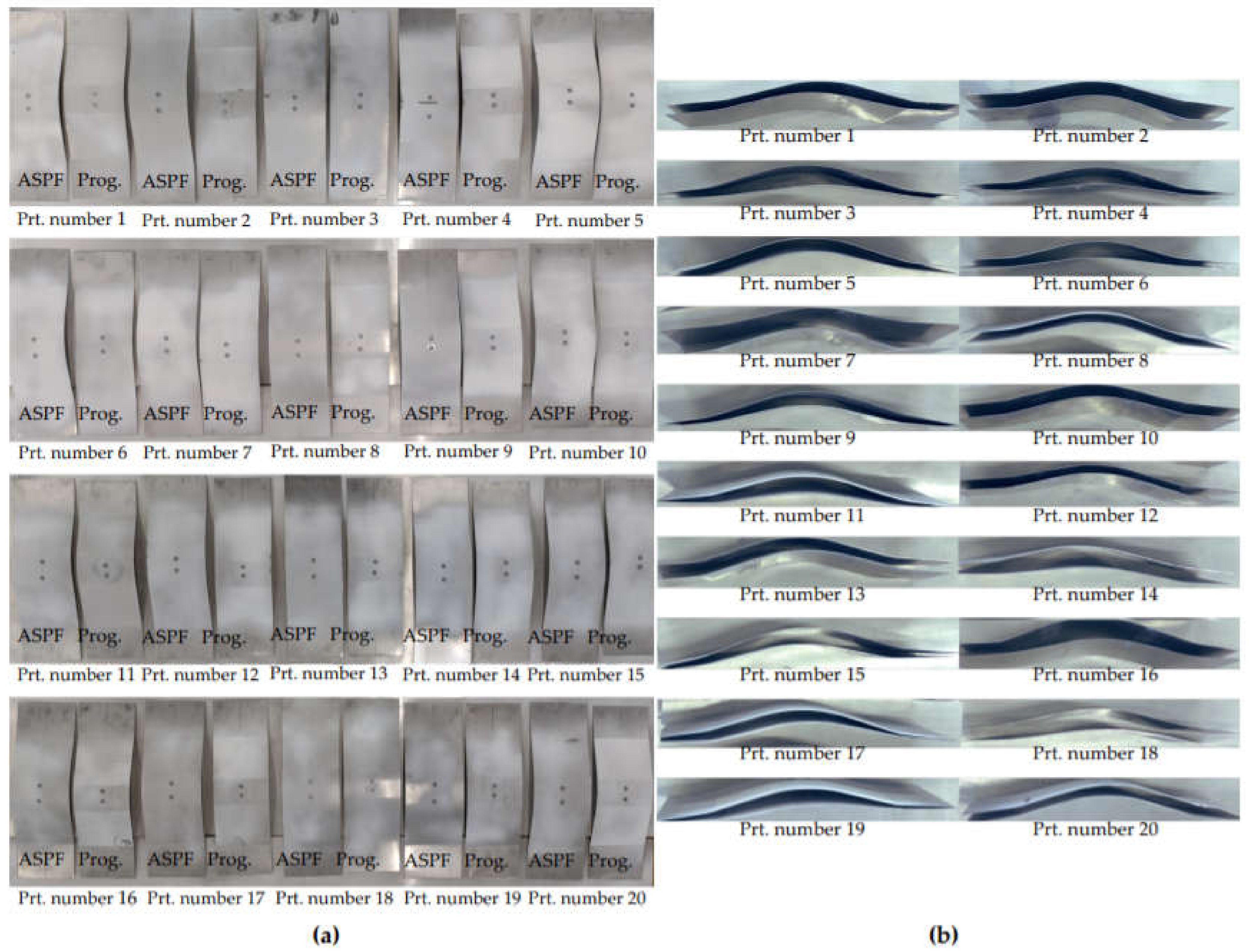







| Video Processing Description | |
|---|---|
| video colour spelling | image colour spelling [45] from red-blue-green to black and white for edge boundary detection; |
| marker detection and lock | the material blanks are sprayed with an anti-reflex coating; if any residual points (light reflections, marks on the part, round corners of the die) still appear, they are cancelled by the software; at this step, by using the Hough circle transformation method [46], the two markers are locked into position and only they are analyzed; |
| auto-calibration | calibrated marks with a fixed diameter (white on black round markers with a radius of 1.5 and 3.5 mm) are used; the auto-calibration algorithm sets the necessary numerical value of the calibration factor; |
| marker movement detection | the Lucas-Kanade track and trace optical flow method [47] is used to analyze the position of each marker with each frame; |
| marker relative position | the position is read as the distance between pixels by using the lower-left corner of the video feed as the origin; the strain is calculated as percentage displacement from the initial to the actual position %. |
| Chemical Composition wt.% | ||||||||
|---|---|---|---|---|---|---|---|---|
| Al | Cu | Fe | Mg | Mn | Si | Ti | V | Zn |
| >99.5 | <0.05 | <0.4 | <0.05 | <0.05 | <0.25 | <0.03 | <0.05 | <0.05 |
| Part. Number | Stretching Pressure Bar | Die Control Frequency Hz | Die Speed mm/s | Die Stroke, Programmed mm | Strain % |
|---|---|---|---|---|---|
| 13 | 0 | 30 | 2 | 30 | 6.75 |
| 10 | 0 | 1 | 0.03 | 37.4 | 7.43 |
| 9 | 11.8 | 2 | 0.06 | 38.3 | 8.26 |
| 16 | 0 | 19 | 1.68 | 50 | 8.42 |
| 7 | 0 | 1 | 0.03 | 50 | 8.82 |
| 17 | 9 | 14 | 1.08 | 30.4 | 8.85 |
| 12 | 9 | 14 | 1.08 | 30.4 | 9.05 |
| 11 | 9 | 29 | 1.84 | 41 | 9.10 |
| 4 | 9 | 29 | 1.84 | 41 | 9.20 |
| 6 | 10 | 28 | 1.84 | 30.9 | 9.75 |
| 15 | 9 | 29 | 1.84 | 41 | 9.80 |
| 19 | 3.2 | 18 | 1.56 | 38.3 | 9.98 |
| 18 | 19.6 | 14 | 1.08 | 41 | 10.09 |
| 8 | 19.6 | 14 | 1.08 | 41 | 10.45 |
| 1 | 19.6 | 14 | 1.08 | 41 | 10.53 |
| 5 | 20 | 1 | 0.03 | 30 | 11.2 |
| 3 | 11.7 | 18 | 1.56 | 50 | 11.92 |
| 2 | 20 | 30 | 2 | 30 | 12.5 |
| 14 | 20 | 30 | 2 | 50 | 12.58 |
| 20 | 12.5 | 1 | 0.03 | 50 | 12.75 |
| Fit Statistics | Strain | Part Radius | Part Height |
|---|---|---|---|
| R2 | 0.9888 | 0.9219 | 0.9504 |
| Adjusted R2 | 0.9735 | 0.8352 | 0.9215 |
| Predicted R2 | 0.8432 | 0.7426 | 0.7933 |
| Adequate Precision | 28.1992 | 9.7440 | 17.5590 |
| Part. Number | APR-P mm | APR-ASFP mm | Die Radius /APR-P Coefficient | Die Radius/APRA-SFP Coefficient | Part Height, Programmed mm | Part Height, ASFP mm | Process Time, Programmed s | Process Time, ASFP s |
|---|---|---|---|---|---|---|---|---|
| 13 | 321.43 | 163.25 | 0.4667 | 0.9188 | 11.5 | 27 | 15 | 132 |
| 10 | 391.26 | 184.44 | 0.3834 | 0.8133 | 9.98 | 26.2 | 1246.7 | 257 |
| 9 | 210.35 | 154.37 | 0.7131 | 0.9717 | 20.2 | 29.8 | 638.4 | 223 |
| 16 | 187.71 | 154.53 | 0.7991 | 0.9707 | 26.9 | 24.7 | 29.8 | 189 |
| 7 | 183.48 | 160.96 | 0.8175 | 0.9319 | 27.2 | 26.5 | 1666.7 | 334 |
| 17 | 321.02 | 184.39 | 0.4673 | 0.8135 | 13 | 26.1 | 28.2 | 215 |
| 12 | 323.7 | 177.34 | 0.4634 | 0.8458 | 12 | 27.1 | 28.2 | 169 |
| 11 | 173.95 | 150.04 | 0.8623 | 0.9997 | 24.7 | 24.3 | 22.3 | 232 |
| 4 | 178.18 | 190.21 | 0.8418 | 0.7886 | 24.6 | 26.4 | 22.3 | 205 |
| 6 | 337.43 | 174.39 | 0.4445 | 0.8601 | 11.9 | 29 | 16.8 | 334 |
| 15 | 202.46 | 159.47 | 0.7409 | 0.9406 | 25.8 | 30.2 | 22.3 | 358 |
| 19 | 314.85 | 189.96 | 0.4764 | 0.7896 | 16.6 | 23.1 | 24.6 | 223 |
| 18 | 160.03 | 152.77 | 0.9373 | 0.9819 | 22.2 | 34.2 | 38 | 351 |
| 8 | 194.7 | 158.15 | 0.7704 | 0.9485 | 22.3 | 34.2 | 38 | 302 |
| 1 | 255.02 | 179.84 | 0.5882 | 0.8341 | 21.2 | 24.6 | 38 | 217 |
| 5 | 186.43 | 176.66 | 0.8046 | 0.8491 | 23.1 | 36.2 | 1000 | 289 |
| 3 | 190.64 | 169.52 | 0.7868 | 0.8849 | 29.7 | 34.7 | 32.1 | 307 |
| 2 | 333.6 | 152.56 | 0.4496 | 0.9832 | 14.3 | 31.7 | 15 | 307 |
| 14 | 178.71 | 151.1 | 0.8393 | 0.9927 | 26.8 | 32.2 | 25 | 195 |
| 20 | 185.47 | 173.41 | 0.8088 | 0.8650 | 28.3 | 32 | 1666.7 | 266 |
| Match by Radius | Part Number | GOM Measurement Comparison | |
|---|---|---|---|
| Programmed | ASFP | ||
| Best-case match part-die | 18 | 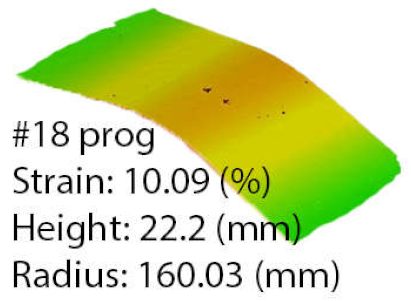 | 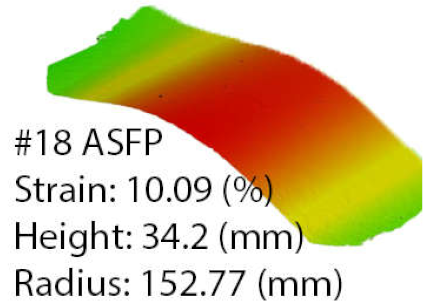 |
| 11 |  | 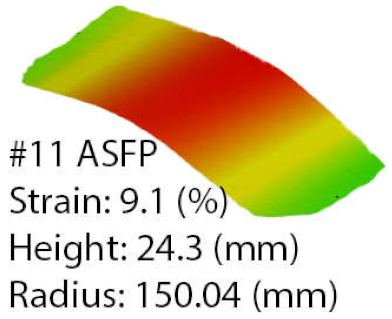 | |
| Match by Radius | Part Number | GOM Measurement Comparison | |
|---|---|---|---|
| Programmed | ASFP | ||
| Worst-case match part-die | 10 |  |  |
| 4 | 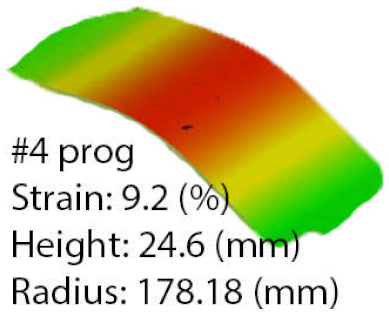 |  | |
| Match by Radius | Part Number | GOM Measurement Comparison | |
|---|---|---|---|
| Programmed | ASFP | ||
| Best-case match part-part | 5 |  | 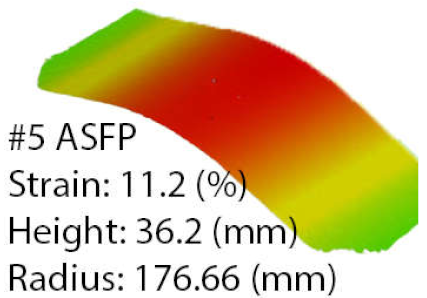 |
| Worst-case match part-part | 2 |  | 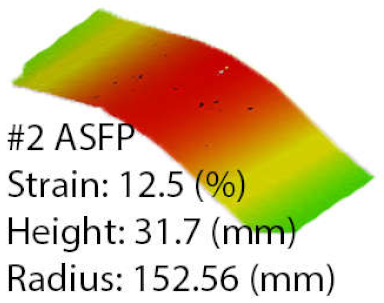 |
Publisher’s Note: MDPI stays neutral with regard to jurisdictional claims in published maps and institutional affiliations. |
© 2021 by the authors. Licensee MDPI, Basel, Switzerland. This article is an open access article distributed under the terms and conditions of the Creative Commons Attribution (CC BY) license (https://creativecommons.org/licenses/by/4.0/).
Share and Cite
Grigoras, C.C.; Zichil, V.; Chirita, B.; Ciubotariu, V.A. Adaptive Stretch-Forming Process: A Computer Vision and Statistical Analysis Approach. Machines 2021, 9, 357. https://doi.org/10.3390/machines9120357
Grigoras CC, Zichil V, Chirita B, Ciubotariu VA. Adaptive Stretch-Forming Process: A Computer Vision and Statistical Analysis Approach. Machines. 2021; 9(12):357. https://doi.org/10.3390/machines9120357
Chicago/Turabian StyleGrigoras, Cosmin Constantin, Valentin Zichil, Bogdan Chirita, and Vlad Andrei Ciubotariu. 2021. "Adaptive Stretch-Forming Process: A Computer Vision and Statistical Analysis Approach" Machines 9, no. 12: 357. https://doi.org/10.3390/machines9120357
APA StyleGrigoras, C. C., Zichil, V., Chirita, B., & Ciubotariu, V. A. (2021). Adaptive Stretch-Forming Process: A Computer Vision and Statistical Analysis Approach. Machines, 9(12), 357. https://doi.org/10.3390/machines9120357









